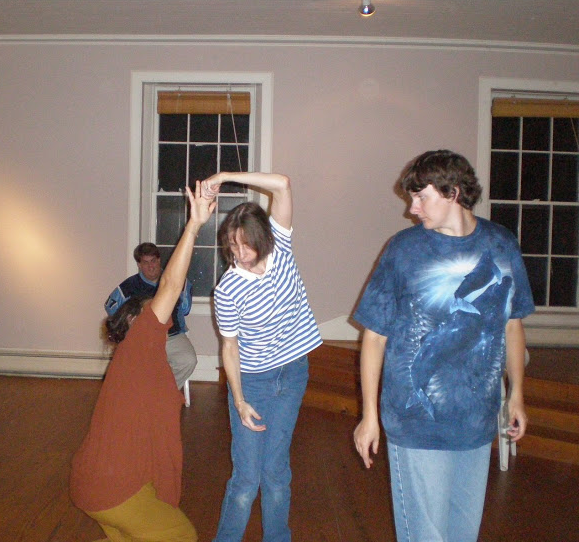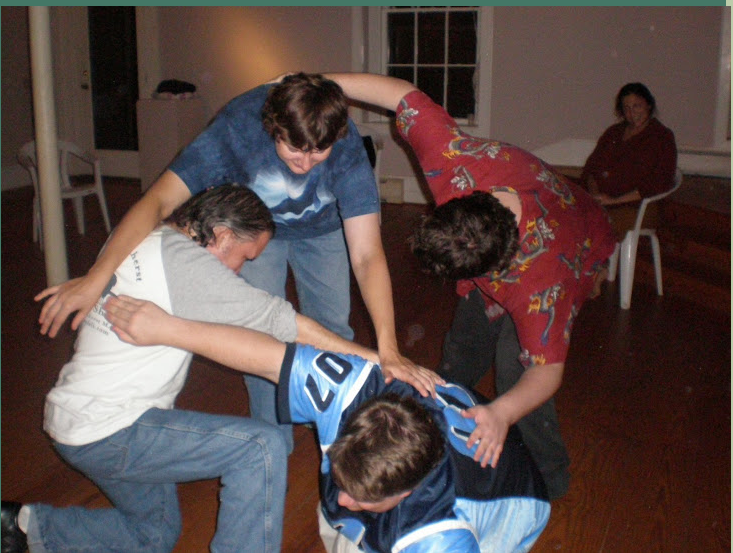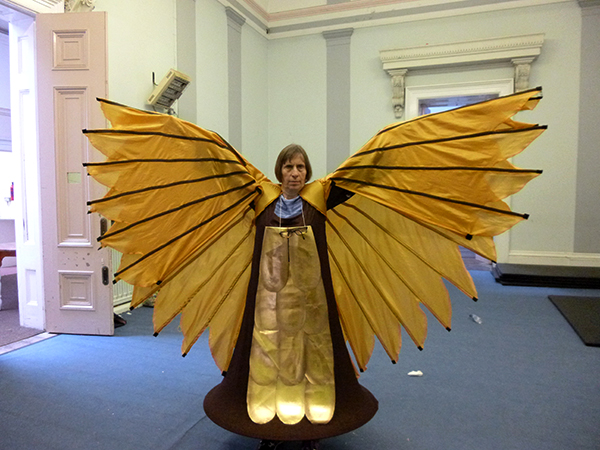Bridging Art and Disability
BY EMMALY WIEDERHOLT
Ezzell Floraniña began The Rainbow Players – a group comprised of people with varying levels of disability labels – in 1999 in Western Massachusetts. Ezzell integrates Theater of the Oppressed, dance, music and visual art as a way for The Rainbow Players to find their creative voice.
~~
What is your personal background in dance and theater?
I always loved to dance, but I grew up in a family with nine children, so taking dance classes wasn’t in the budget. I started dancing when I turned 30 while living in Canada and working as a teacher of the deaf. Although I integrated arts into my teaching, I knew I needed to express myself through the arts too. So, I started taking modern dance classes.
I saw a dancer named Margie Gillis perform in a concert in Victoria where she integrated sign language into her movement. Since sign language was part of my background, seeing her work empowered me to begin choreographing a kind of poetry-dance.
In 1985, I took a weeklong intensive in Forum Theatre, from Augusto Boal’s “Theatre of the Oppressed”. I fell in love with it as a form and as a way to deal with social injustices. I started using Theatre of the Oppressed in my work with deaf students at the high school level. In the classroom, some of the kids had more hearing than others and didn’t want to feel stigmatized by using sign language. We built scenarios based on that, letting them see that the kids who are profoundly deaf have a right to be signed to, even if others only preferred to speak.
When I moved to Western Massachusetts in 1994, I continued working with the population of people who are the nearest and dearest to my heart. They are one of the most on-the-fringe groups of people—those with a range of learning disability labels.
In 1997, I was hired to facilitate a grant project, to pair teens and adults in the community as peer-companions, those with labels and those not labeled. Parents were finding that their children with labels of developmental disabilities were lacking “friendships” and seemed to have this kind of relationship only with those that were paid to be in their lives as support staff and doctors. Soon the town created a position for me as the Special Needs Director through the recreation department.
As a social event for the companionships, I started a once-a-month cabaret to bring the groups together in a social setting, and saw that they loved to perform. This was the genesis for The Rainbow Players.
In April 2000, we performed our first original show, cabaret style. The first performances integrated dance, song, or whatever art lifted them up. One man was from Cambodia and, in the process of escaping to Thailand, he was badly beaten sustaining head injuries, creating communication difficulties. He loved dancing to Michael Jackson tunes and he was amazing at it.
From there we started to build more thematic shows. Theatre of the Oppressed was always at the foundation. We worked with this form to tell their stories. If there was an oppression in the story, did it get dealt with? And if not, could the audience contribute alternatives for the person living the oppression?
For instance, when one man was in junior high, boys in the lunch room would say, “Slave, take my tray.” He did this for a year because he wanted them to be his friends. I asked him if we could perform this as a scenario in one of our early shows. Eventually, this scenario led us to create a song called “Back Off Bully You.” It all started with acting out the oppressive scenario. At one point recently, my group informed me that they left feeling lousy because acting out the scenarios dredged the experiences up again. It made me wonder what might be the best ways to depict a situation of oppression without re-triggering it. I think dance may be the way.
Movement demonstrates a situation without all the words. It’s been an interesting evolution, blending theater and improvisation with movement. That’s how we’re working now. I introduce movement prompts, similar to writing prompts in creative writing classes.
Judith Snow from Toronto, a woman who uses a wheelchair and is quadriplegic, said once: “Walking is an ordinary gift; not walking is an extraordinary gift.” I’ve used that quote for years with my student interns to help them adjust their thinking as to what we experience as giftedness.
Can you talk a little more about the make-up of The Rainbow Players?
The group started in 1999, some in high school and some adults from the community. Those who were high school students are now in their 30s, while the others who are older are in their early 60s.
There are about 10 or 12 in the core group with community members who have come and gone as performing members. There are a few who would be labeled Asperger’s. A few have had head injuries. One woman in her early 60s had a high fever as an infant which left her with a kind of cerebral palsy. And there is one man with Down Syndrome. He has some difficulty with initiating conversation but is an amazing puppeteer. When he has puppets in his hands, he’s so connected in his speech abilities. Others have a mix of learning disability labels. It’s quite a wide group in terms of abilities.
Given the myriad of their abilities, what does your process look like?
Our process is a collaborative approach through improvisation. We generally start with a warm up and follow with theater games and improv. Then, for an upcoming show, to find out what they want to present, we brainstorm main themes and explore them through a process of improvisation. The themes have ranged from bullying scenes to dreaming and reaching for dreams. We use masks and puppets, often created by the actors themselves. Though I’m certainly the director, it’s a collaborative process. Over the 16 years, we’ve mounted about a dozen original productions and performed internationally in festivals in Ireland and England and as far west as Chicago.
Pictured: Karen Weneczek from the Rainbow Players’ trip to the UK in 2012 for the London Olympics
What kind of impact do you perceive being a part of the Rainbow Players has had on the members’ lives?
They each seem to be standing taller, living more confidently and self-determined in their lives. They stand up for what they want or need. One man, who loved doing Elvis impersonations in our shows, now books his own gigs! I think they have a stronger sense of themselves and are much more able to speak out about injustice with the conviction of experience through the art forms of theater and dance.
The members of the Rainbow Players don’t accept the term, “disability” to describe themselves. They’re proud of who they are. There’s a lot in the literature about the arts raising self-esteem. The Rainbow Players are authentic and amazing. We are shifting the way “disability” is seen in the community and in education. Replacing it is the brilliance and uniqueness of each person, with or without labels.



